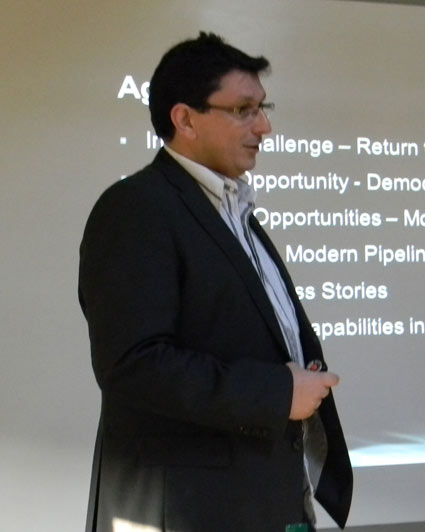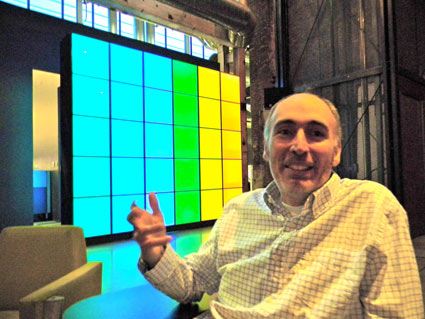Built for Today's Off-the-Shelf "Modern VFX Pipeline," Scalable 2012 Releases Also Target Massive Rise in Online Video Advertising and the Future of Gaming

Marc Petit
But productivity, Petit stressed, is top of mind in the current suite of tools. “We’re using the GPU very well now,” he said. “The next challenge, however, will be to share that GPU across platforms and we have a lot of research going on right now about rendering in the cloud.”
Responding to the perennial question about Autodesk’s crowded animation package offerings, Petit offered little room for speculation. “We aren’t going to get rid of one animation program, period,” he said. “Customers of each package, whether it is Maya, 3ds Max or Softimage, mostly tell us, ‘Don’t move my cheese.’ It’s as simple as that. But we also know that they are using two, if not all three of these packages in the same pipeline. So how do we respond to that? By enhancing the commonality between them. The new artists we’re seeing rising up through the ranks are ‘suite students’: they expect the UIs to work together. They don’t expect modeling and animation to be separate as it was fifteen years ago.
Highlights in Autodesk DEC 2012 Releases
Maya 2012
According to Maya senior product manager Cory Mogk, the latest version of Maya is all about its viewport enhancements. With depth of field control for real-time DOF and motion blur, node-based render passes and the ability to edit animation directly in the viewport, the new version pushes the envelope in real-time control. During our demo, editable motion trails could be seen with impressive full-screen effects.
Additional improvements include those in Fluid Effects, which now boasts a range of pouring, splashing and boiling effects as part of its algorithm. Another little-known Maya 2012 perk: If you’re enrolled in an animation or other VFX course, you can download the full Maya 2012 package for free for 36-months. You’ll need a legit faculty or student e-mail address to take advantage of this

Cory Mogk, Senior Product Manager for Maya and MotionBuilder, inside Autodesk’s HQ in Montreal
3ds Max 2012
In Max’s 20th anniversary year, Rob Hoffmann, Autodesk’s Senior Product Marketing Manager for 3D, pointed to the Max product team’s latest initiative, dubbed “Excalibur,” as the future of creative potential inside subsequent releases of the software. ” We want to enhance creativity without bogging them down,” he said. “It’s about managing complexity.”
A new library of Substance Smart Textures means artists can now create and customize resolution-independent textures. Also notable is the NVIDIA GPU-accelerated iray Renderer from mental images. Need to create UVW maps in less time or better control your brushstrokes while painting and sculpting? You can do that, too. Artists can now save and load brush settings for more quickly toggling between presets.
Softimage 2012
For Softimage users, it’s all about the nodes in this new version. With ICE node-based modeling, you can do particle meshing and geometry fracturing and create custom primitives while preserving your UV attributes. You can also now take your creations out to Flame or Smoke for final finishing.
Smoke 2012 for the Mac
“Smoke on the Mac is really becoming the platform for Smoke,” said Marc Hamaker, who as Senior Manager Product Marketing, Creative Finishing, is responsible for Flame Premium, Flame, Flare, Smoke on the Mac and Lustre. Used mainly in commercial post, Smoke on the Mac is all about the integration with Final Cut Pro, he added, noting that a wider user base in corporate video and Web/mobile production is also discovering its charms. “I’d say about 60 % of our new customers are new accounts.” Hamaker outlined
a number of new features, including out-of-the-box S3D finishing (tools for editing, viewing, monitoring and compositing S3D content); added graphic card support and support for a number of Mac laptops and iMacs, as well as AJA KONA 3G and the Avid Artist control surfaces in the new trial download; a new Action Node Bin that makes it easier to launch the software; and a brand new lighting system that includes cast shadows and photoreal 3D lighting artifacts. Also inside the box is Flame FX, a new suite of tools extracted from Flame that includes Damage, Deform and Edge Detect. “This isn’t a Flame,” Hamaker pointed out. “These are everyday tools for everyday tasks.”

Did you enjoy this article? Sign up to receive the StudioDaily Fix eletter containing the latest stories, including news, videos, interviews, reviews and more.










Leave a Reply